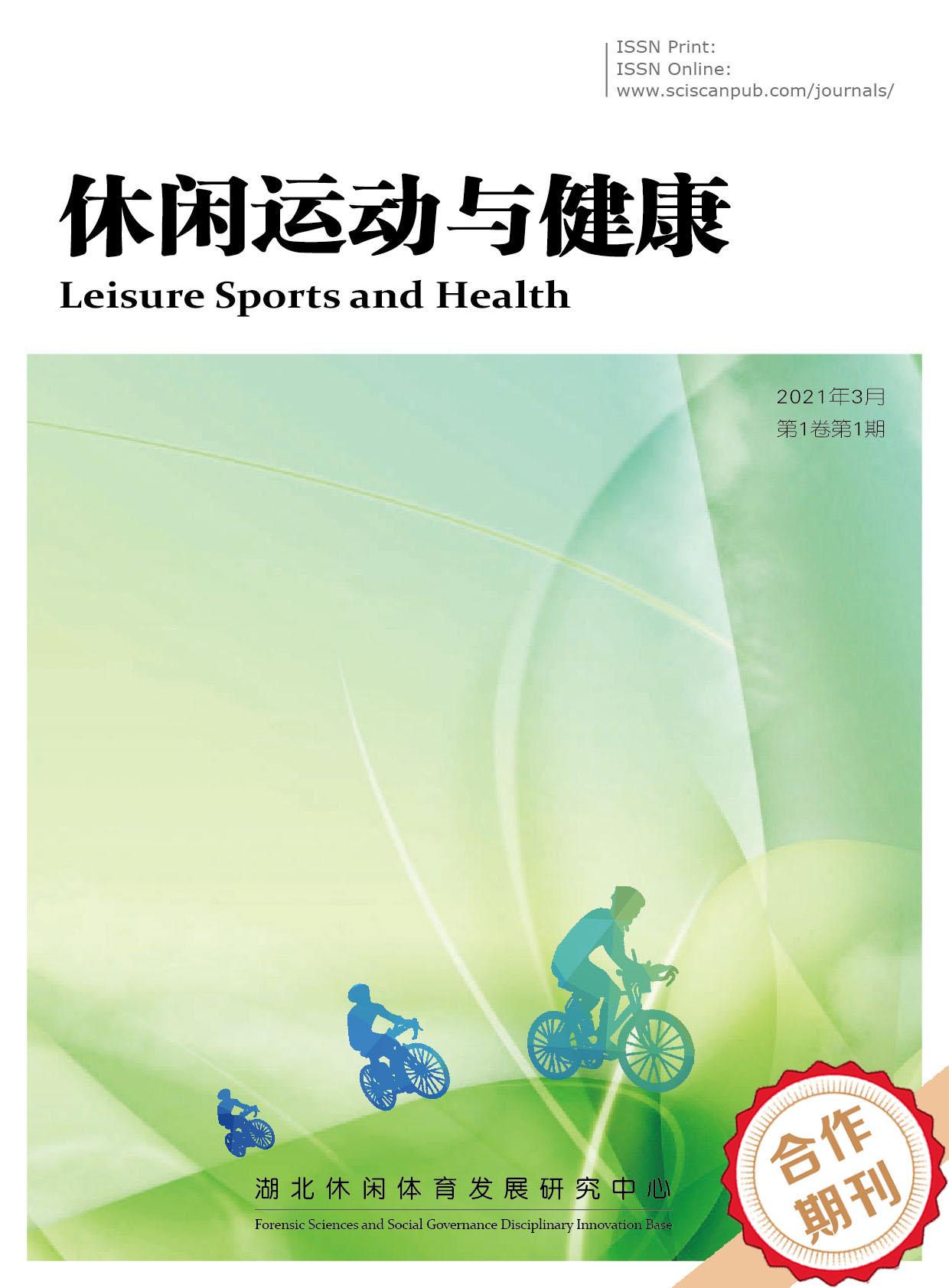Leisure Sports and Health
我国体育保险研究的演进、热点及前沿——基于CSSCI 来源期刊的CiteSpace 分析
The Evolution, Hotspots and Frontiers of Sports Insurance Research in China: A CiteSpace Analysis Based on CSSCI Source Journals
- Authors: 曹天义
-
Information:
湖北大学体育学院,武汉
-
Keywords:
Sports insurance; CSSCI journal literature; Visual Metrology Analysis体育保险; CSSCI期刊文献; 可视化计量分析
- Abstract: This article uses China National Knowledge Infrastructure (CNKI) as a literature retrieval platform and CiteSpace knowledge graph visualization software analysis tool to conduct bibliometric mining of 119 CSSCI source journals in the field of sports insurance in China, including time evolution, hotspots, and cutting-edge trends. The results indicate that: (1) examining the research process in the field of sports insurance, the time schedule of the number of published papers clearly reveals three stages of development: from the initial emergence of the field in 1994 to the exploratory enlightenment period in 2001; Subsequently, with the opportunity of the 2002 Olympic Games, there was a relative growth period from 2002 to 2010; Since 2011, it has entered a relatively stable stage of development, but the fragmented characteristics of research still exist. In terms of regional distribution, the spatial layout of sports insurance research institutions in China exhibits significant non-equilibrium characteristics. (2) Analyzing the co-occurrence network of keywords, it can be seen that high-frequency and high centrality keywords are closely related to themes such as competitive sports insurance, school sports insurance, and domestic and foreign sports insurance, forming the core of knowledge clustering. Furthermore, the knowledge structure framework constructed by these clustering hotspots mainly focuses on seven key areas, including sports insurance itself, athlete protection, integration of social insurance systems, exploration of response strategies, Olympic related insurance practices, and economic effects of sports events. (3) Observing the dynamic evolution of the knowledge graph of keyword time zones, it is not difficult to find that the initial and recent achievements of research activities were relatively sparse, while the middle period experienced a significant surge in research results, showing a development trend of “relatively rich in the middle and relatively flat at both ends”. (4) The core authors and institutions currently have a representative group of scholars in this field. However, the overall research strength is still scattered, lacking effective integration and in-depth academic exchanges, which to some extent restricts the further expansion of research depth and breadth. 本文以中国知网为文献检索平台,利用CiteSpace知识图谱可视化软件分析工具,对中国体育保险领域CSSCI来源期刊的119篇文献进行时间演进、热点和前沿趋势的文献计量挖掘。结果表明:(1)审视体育保险领域的研究历程,其论文发表数量的时间进度鲜明地揭示了三个发展阶段:自1994年领域初现端倪,至2001年的探索启蒙期;随后,伴随着2002年奥运会的契机,迎来了2002至2010年的相对增长期;自2011年起,步入了一个相对稳定的发展阶段,但研究碎片化特征依旧存在。在地域分布上,我国体育保险研究机构的空间布局则显现出显著的非均衡性特点。(2)分析关键词的共现网络,可见高频且高中心性的关键词紧密围绕竞技体育保险、学校体育保险及国内外体育保险等主题展开,形成了知识聚类的核心。进一步地,这些聚类热点所构建的知识结构框架,主要聚焦于体育保险本身、运动员保障、社会保险体系的融合、应对策略探讨、奥运相关保险实践、体育赛事经济效应等七大关键领域。(3)观察关键词时区知识图谱的动态演变,不难发现研究活动的初期与近期成果相对稀疏,而中期则经历了研究成果的显著激增,呈现出一种“中间比较丰富,两头相对平缓”的发展态势。(4)核心作者与机构,当前已有一批具有代表性的学者群体在该领域内,然而,整体研究力量尚显分散,缺乏有效的整合与深入的学术交流,这在一定程度上制约了研究深度与广度的进一步拓展。
- DOI: https://doi.org/10.35534/lsh.0402022
- Cite: 曹天义.我国体育保险研究的演进、热点及前沿——基于CSSCI来源期刊的CiteSpace分析[J].休闲运动与健康,2024,4(2):125-132.
1 引言
中国银保监会等13部门联合发布《关于促进社会服务领域商业保险发展的意见》,提出加强发展体育领域的商业保险并积极开发专属保险产品。2023年实施的新《中华人民共和国体育法》中明确提出“国家建立健全体育保险机制,其中以学校体育保险、运动员商业保险、体育意外伤害保险和场所责任保险为主要内容”[1],进一步体现了党和政府对体育保险的关注,是体育强国发展的需要。体育产业的高质量发展,体育保险业作为体育产业的主要组成部分,关键促进体育保险发展,为建设体育强国奠定坚实的基础。近年来,体育保险越来越受到关注,体育活动往往伴随着一定的风险,包括运动员受伤、比赛取消、场馆损坏等。体育保险是规避和转移风险的重要工具[23],也是体育风险管理的核心组成部分,在保障个人和组织利益、促进体育发展、遵守法律要求、支持商业体育、履行社会责任以及平衡风险等方面发挥了重要作用[2]。体育保险为个人、体育组织和场馆提供了保障,可以在发生不测事件时提供经济支持,帮助受益人应对损失。有了体育保险,运动员和体育组织更有信心积极参与各种体育活动[22]。这鼓励了体育的发展,促进了人们更健康、积极的生活方式。回顾中国体育保险领域的时间推进和空间分布,探讨空间差异及随时间的演变。分析当下热门话题以及相关研究的趋势和发展方向以寻找未来的发展战略机遇与思路,进而提出改进建议,帮助体育组织和政府采取措施降低事故和伤害发生的可能性,提高体育活动的安全性。这些研究成果也可以用来指导法律法规的制定和政策的更新,以更好地满足社会的需要和保障参与者的权益。
目前已有许多研究者对体育保险研究领域展开探讨,其中,国内对体育保险的研究起步较晚,主要集中在中外体育保险对比研究、体育保险市场研究、学校体育保险研究、体育保险法规政策研究等方面;国外体育保险研究主要集中在体育保险理论与实践研究、运动伤病与体育保险研究、体育保险理赔数据研究等。总的来看,对体育保险领域的研究趋向、热点以及梳理演变轨迹的研究文献较少。鉴于此,本文运用CiteSpace知识图谱可视化软件分析工具,对中国知网数据库收录的体育保险相关文献进行梳理和挖掘,全面把握我国体育保险领域研究的研究趋向、热点及发展趋势,弥补已有研究空白,为体育产业高质量发展、实现体育强国建设目标提供参考。另外,体育保险研究有助于保险公司更好地理解体育领域的需求,从而开发出适应性强、保障更全面的体育保险产品,有助于推动保险行业的创新,提供更好的服务。
2 数据来源与研究方法
2.1 数据来源
以中国知网为检索平台,通过主题检索“体育保险”,检索日期确定为2023年4月,被南京大学“中文社会科学引文索引(CSSCI)来源期刊”收录的期刊作为总体研究对象,其中包括13本体育类期刊,7本非体育类期刊。检索到相关文献总计133篇,文献筛选由两人平行进行,以确保筛选工作的独立性与互补性。在筛选环节中,产生的矛盾通过讨论解决,达成一致的筛选结论[7,12],人工剔除非体育保险领域的研究文献,最终获取有效文献119篇。
2.2 研究方法
本文聚焦于1988年至2023年这一时间跨度,借助CiteSpace软件工具,对中国知网内收录的、源自CSSCI的高质量期刊上刊载的共计119篇关于体育保险研究的文献进行了系统性的计量分析。旨在通过此分析框架,全面而客观地揭示我国体育保险研究领域的历史演进脉络、当前研究热点以及前沿探索方向,并进一步探讨该领域未来可能的发展趋向与潜在的研究机遇,包括发文量的时序演化与空间分布特征、文献关键词、核心作者、核心机构等方面,并通过关键词聚类分析体育保险领域的研究热点、前沿和趋势。
3 中国体育保险领域研究的时序演化特征
文献数量是衡量某一知识领域研究进展及热度的重要指标[4]。如图1数据显示,纵观该领域研究文献,其数量总体表现为增长逐渐减缓。在过去的1994年至2023年之间所发表的体育保险主题研究文献呈现波动变化的趋势,整个演化过程呈现了一个“Z”字母的“几”字形。1998年桑兰事件之后,在国人考虑如何处理因意外导致的运动伤害问题时,体育保险作为一种解决方案逐渐进入人们视野,同时也启发了对运动员保障的研究探讨。2001年成功申办北京奥运会以来,推动我国体育保险研究进入新的研究阶段,奥运保险、运动员保险、赛事保险研究领域最为活跃,发文量达到最高38篇,研究数量并呈现线条式增长。2002年《学生伤害事故处理办法》的出台,使得学校体育保险研究文献数量达到第一次高峰,然而,因2005年山西沁源学校体育特大伤害事故的发生,教育部不得不紧急发布《教育部关于加强学校体育活动安全防范工作的紧急通知》,其中研究文献增长态势迅猛,随着北京奥运会的即将举办,2006年奥运保险研究热度迎来了最高峰。同时国家对体育的重视,2023年新《中华人民共和国体育法》的正式施行,将激发体育保险研究热潮,如2023年王旭升学者在《体育学刊》上录用的两篇学术期刊,进一步为相关学科研究提供了素材支持。因此,可以预见体育保险研究未来仍将保持增长态势。

图1 文献发表时序曲线图
4 中国体育保险领域研究的前沿热点与可视化分析
4.1 关键词共现分析
中介中心度是衡量文献关键词重要性的一个量化指标[5]。中介中心度大于等于0.1的关键词往往值得我们关注。中介中心性代表了网络图中对该关键词的研究对其他关键词的中介作用。中介中心性越高,其影响越显著。因此,研究以频率和中介中心性作为研究热点的判断依据[14]。如表1所示,频次排名较高且中介性大于0.1的关键词包括“体育保险”“保险”“运动员”“社会保险”等。这些关键词可以帮助我们更好地理解体育保险研究的主要内容和发展趋势。随着体育产业的不断壮大,体育保险研究也将继续深化,以适应不断变化的市场需求和社会需求。
表1 高频关键词词次、中心性关键词排序
| 序号 | 关键词 | 频次 | 中心性 |
| 1 | 体育保险 | 72 | 1.2 |
| 2 | 保险 | 19 | 0.23 |
| 3 | 运动员 | 12 | 0.16 |
| 4 | 社会保险 | 7 | 0.1 |
| 5 | 对策 | 9 | 0.07 |
| 6 | 奥运保险 | 7 | 0.06 |
| 7 | 中国 | 7 | 0.05 |
| 8 | 奥运会 | 8 | 0.03 |
| 9 | 体育 | 8 | 0.01 |
| 10 | 体育经济 | 7 | 0.01 |
4.2 关键词聚类分析
1)竞技体育保险研究
该聚类主要包括运动员、社会保障、竞技体育、奥运会、奥运保险等5个关键词。对研究内容进行梳理,该聚类包含运动员保险与奥运保险两大部分,相关研究兼具定量与定性。通过考察我国体育保险研究的缘起,运动员保险是学者最早关注的,也是关注度最高的。
研究者主要从社会保障和法制的角度对其进行探讨,考察运动员的医疗风险、养老风险、失业风险。希望用保险的手段来转移运动员的风险,补偿风险带来的损失。其中医疗风险最值得关注,优秀运动员的死亡率小于重伤率,与一般行业状况相反,这是体育运动伤残风险的特殊之处。优秀运动员的重伤率远高于其他行业,位列第一,甚至比采矿行业的重伤率高出许多[24]。针对运动员的医疗风险,《优秀运动员伤残互助保险暂行办法》自2004年实施以来,在解决运动员伤病后顾之忧等方面,发挥了重要作用[17]。优秀运动员伤残保险被认为是首次专门为国内高水平运动员大规模保险[6]。然而,优秀运动员伤残保险的保额无法覆盖运动员重伤过后的医疗费用。也有研究者提出以商业补充医疗保险提供更全面的保障,遗憾的是,运动员商业保险供给不足。运动员保险制度的演进历程中,持续面临多重挑战,主要源于法律框架的尚不完善、资金筹措途径的局限性、保险覆盖面的狭窄、险种设计的单一性以及保险中介服务体系的不成熟[1,20]。在探讨退役运动员安置难题的过程中,退役运动员的保险问题日益成为关注的焦点。为构建退役待安置运动员的基本社会保障体系,研究者们从社会保险与伤残补偿保险两大维度入手,力求全面覆盖。具体措施包括优化运动员退役前的养老保险机制,并重新设计退役后的养老保险制度框架,以此为基础,进一步丰富和完善退役运动员的保险保障体系,确保他们在离开竞技舞台后仍能享有稳定的社会保障。
自2001年中国成功获得2008年北京奥运会主办权以来,鉴于奥运赛事所蕴含的独特风险特性,奥运保险议题便逐渐引起了社会各界的广泛关注与深入探讨[9]。进入体育保险研究的发展机遇期,奥运保险是最值得关注的领域,研究者主要从奥运会经济效益的角度对中国体育保险进行探讨和展望。他们普遍关注奥运险种,重视险种的研发,借助奥运会构建完善的体育保险体系。作为世界上最大的体育赛事,奥运会蕴含着巨大的商机和许多潜在的风险。为了应对奥运风险,我们需要认识到奥运风险不同于其他类型的风险。除了运动员的风险,我们还需要确保覆盖所有其他风险,包括运动员收入损失、体育财产设备损失、运动员人身意外伤害、体育场馆责任风险等[15]。
2)学校体育保险研究
该聚类主要包括学生、学校体育、伤害事故等5个关键词。学者最为关注的是针对学生与校方而言有关保险方面是否充足。学校体育的风险是学校教育中风险最大的部分,学校体育保险自然存在纠纷和矛盾。争议的焦点在于学校体育意外伤害和学校责任的划分[8]。但是,对于学校体育伤害事故的处理和调解,并没有具体的、有针对性的法律规定。当前《学生伤害事故处理办法》《民法典侵权责任编》已无法解决校方责任的划分纠纷。因此,研究者以学校体育保险为切入点,认为学校体育伤害赔偿以民事责任为主,大多以经济给付的形式承担相应的责任。保险作为转移经济赔偿责任的方式之一,已经受到人们的重视,体育保险作为一种责任承担方式也逐渐介入,被视为解决学校体育伤害赔偿纠纷的有效途径[10]。我国学校体育伤害事故赔偿正在经历着由“过错责任”向“无过错责任”的转变,传统赔偿以过错为原则,过错责任是侵权法框架下的基本理论,此框架下侵权赔偿具有明显的被动性与滞后性,而在无过错责任制下,受害者只需证明发生的损害与体育运动之间存在因果关系即可[10]。学校行为无不当的,则不承担责任,也不会执行理赔条款。另外,可以借鉴日本的经验。鉴于学校的责任,学校体育伤害事故发生后,学校体育保险基金专业管理机构是事故处理的责任部门,由“健康教育促进会”负责处理[16]。在现有的保险制度中,学校购买学校责任险,学生及其家长自愿购买人身意外伤害保险是最可行、最有效的方式。但两种保险在处理学校体育伤害事故时都有一定的局限性。自愿性的学生平安保险往往包含高风险体育活动中的意外伤害,而强制性的“校方责任险”将其主要保障范围限定在校方对于学生意外伤害事故存在过错的场合[25]。
3)国外体育保险研究
该聚类包括中国、美国、日本、体育4个关键词。这类研究旨在找出中外体育保险的差距,为我国体育保险的发展提供参考。研究者通过对比中美日三国法律规定、中介服务体系、融资渠道、人才培养、保险意识、体育保险市场的经营主体、社会保险和商业保险险种、体育保险的保险对象、体育保险市场的运行机制、体育保险制度的运作情况等,揭示了我国存在的问题及可供借鉴的经验。
学界对美国的研究突出表现在体育保险体系方面,美国体育保险的覆盖面毕竟广,自1935年《社会保障法》颁布以来,美国形成了一套以残疾和医疗保险、失业保险、公共救助和健康福利服务为重点的社会保障体系[26]。美国体育商业保险涵盖竞技体育、群众体育和学校体育,具有投保范围广、险种丰富的特点[29]。美国《金融服务现代化法案》的实施,使金融机构能够更好地配置和利用资本,提高资本运营效率,促进金融创新。同时,允许财产保险和人寿保险兼营将在一定程度上促进美国体育保险制度的发展。然而,美国体育保险具有强制性,美国的体育保险原则上实行自愿投保,但对运动员参加保险有明确规定,不参加政府体育保险计划的运动员不能参加竞技体育比赛,这在一定程度上造成了事实上的强制体育保险[28]。
学术界对日本的研究主要集中在法律方面。为了推动体育保险,日本颁布了多部法律,如《日本学校安全协会法》和《日本体育与学校保健中心法》[21]。日本有专门的《中小学健康促进法》,建立了学生意外伤害保险。在日本学校体育保险相关法律的推动下,日本以“学校灾害互助保险”制度为基础,逐步演变为涵盖保育所、幼儿园以及高等学校的“学校事故互助支付制度”,该制度也成为《日本体育振兴中心法》中的一项重要内容[11]。另外还有体育保险保障基金制度,该制度使日本体育保险市场建立起了较为完善的风险自救机制,提高了依靠体育保险市场自身力量防范化解风险的能力,从而切实保护投保人和被保险人的利益,维护了体育保险市场的稳定[27]。日本确立的新体育保险市场制度体系要求参加体育赛事的运动员必须加入保险,并逐步建立起了政府和保险公司合作的体育赛事风险保险制度。然而,我国有关体育保险的文件层次较低,多以“意见”“办法”等形式出现,缺少专门的法律法规[19]。鉴于此,从法理学角度对体育保险法进行深入研究是未来我国体育保险研究的重点方向。
通过对国内外相关研究成果的梳理可见,研究者多关注日本社会保险体系、学校体育保险体系和美国体育保险的系统完整性。美国和日本都先后制定了相关政策。首先是允许财产险和人寿险兼营的政策,从而扩大了保险企业的经营范围,激励了各保险公司积极主动地开发新的体育保险险种。遗憾的是,我国现行法规不允许兼业经营,这使得我国成立专门的体育保险公司是发展体育保险的必经之路。其次是保险费率的自由化政策,这是美国和日本竞争型运行机制的又一个明显特征[11]。最后是要求参加体育赛事的运动员必须加入保险。
4.3 关键词时区分析
如图2所示,为了得到更好的图谱,gamma值设置为0.46,其中Begin和End分别代表关键词出现的开始和结束年份,强度代表突变强度,红色条代表突变的持续时间。

图2 关键词突现图谱
图表目前按照突变起始年份排列,首次出现在体育保险领域的是运动员的社会保险,在1995—2002年具有很高的研究热度,突现强度达到2.52和2.09。因为竞技体育具有潜在的危险性,“桑兰事件”后,运动员的保险保障必然得到关注,运动员社会保险可作为体育运动的风险转移手段[6]。鉴于日本有完备的体育保险法规,2001年《国民健康保险法》第三次修订后[3],日本的体育保险研究在2002—2005年具有较高的热度。在2004—2008年,体育保险领域对奥运保险研究较多,但随后热度下降。随着2008年北京奥运会的完美举行,体育保险市场化大大促进了体育经济发展,“体育经济”在2008—2016年研究热度高。我国《社会保险法》的颁布基本确立了体育保险结构,“保险结构”在2012—2015年研究热度高。
5 学术共同体推动体育保险领域理论发展
5.1 核心作者分析
在评估作者的学术能力时,其论文发表量是一个重要的量化指标。为精确描述近期内作者的科研活跃程度,本研究聚焦于第一作者身份下的论文发表情况,并进行了统计。如表2所示,我们挑选了论文发表量位居前八的学者作为分析对象,他们主要根植于高等教育机构。其中,邱晓德以其卓越贡献脱颖而出,共计发表核心论文7篇,显著地凸显了其在体育保险研究领域内的领导地位与学术影响力,进而为界定该领域内核心作者的论文发表阈值提供了重要参照。根据普赖斯理论,核心作者发表的论文数按以下公式计算:

该模型以研究样本中发表量最多作者(Nmax)的论文数为基准,通过特定公式推导出核心作者应达到的最低论文发表量(M)[13]。鉴于Nmax已确定为7,代入公式运算后,得出M=1.97,我们设定M的阈值为2。因此,在该领域内发表至少2篇论文的作者,均可被视为核心作者群体的重要组成部分,这些学者共同构建了该研究领域的知识与文献交流网络。值得注意的是,位列发文量第六的作者其贡献量占据了总发文量的四分之一,这一数据强有力地证明了核心作者群体在体育保险研究领域的核心地位与显著贡献,他们不仅是知识创新的引领者,也是推动该领域持续发展的重要力量。
表2 研究核心作者群
| 排名 | 作者姓名 | 作者机构 | 发文数 | 研究内容 |
| 1 | 邱晓德 | 天津财经学院 | 7 | 竞技体育保险、学校体育保险、体育保险业 |
| 2 | 周爱光 | 华南师范大学体育科学学院 | 6 | 日本学校体育保险、国内外体育保险 |
| 3 | 陈志凌 | 大庆师范学院体育学院 | 6 | 美国体育保险、运动员保险、我国体育保险 |
| 4 | 孙娟 | 辽宁师范大学体育学院 | 5 | 美国体育保险、运动员保险、我国体育保险 |
| 5 | 张锋 | 安徽师范大学体育学院 | 3 | 奥运保险、美国体育保险、运动员保险 |
| 6 | 黄贵 | 南通大学体育科学学院 | 3 | 游泳保险、滑雪保险、登山及户外运动保险 |
| 7 | 苏永骏 | 南通大学杏林学院 | 2 | 游泳保险、登山及户外运动保险 |
| 8 | 李海 | 河南大学体育部 | 2 | 国外体育保险 |
5.2 核心机构分析
运用CiteSpace软件分析发现,发文量在2篇及以上的核心机构共15家。如图3所示,结果显示华南师范大学体育科学学院、天津财经学院、山西大学体育学院、南通大学体育科学学院、辽宁师范大学体育学院、大庆师范学院体育学院、大连大学体育学院、武汉大学法学院、中国政法大学体育法研究中心、对外经济贸易大学保险学院、安徽师范大学体育学院、山东师范大学体育学院、河南大学体育部等研究机构在体育保险研究中最为活跃。特别是华南师范大学体育科学学院发文量累计10篇。科研机构之间的合作不够紧密,大多是独立的研究机构,缺乏优势互补。通过深入分析发现,院校之间的联系大多在体育学院内部,部分院校由于地域限制,表现出与邻近地区或相关附属院校的紧密合作。对外经济贸易大学保险学院、武汉大学法学院和华南师范大学体育学院没有实现资源共享和优势互补。从地理位置上看,研究机构覆盖华中、华南、华北。研究表现出明显的地域偏向,说明目前的研究以我国中东部地区为主。证明体育经济发达地区对体育保险的研究更为活跃。

图3 研究机构共现图谱
6 研究结论与展望
通过研究得出以下结论:目前没有研究对体育保险进行了综述性阐述,对体育保险文献进行定性、定量的研究较少。相关文献研究范式单一,相关文献的理论构建不够成熟,体育保险研究呈现明显的滞后性。
(1)体育保险领域学术研究按时间进度分为三个阶段,包括1994—2001年的探索启蒙期;2002—2010年的相对增长期;2011年起至今相对稳定的发展阶段。
(2)体育保险领域学术研究从研究内容上看,研究碎片化特征依旧存在。
(3)地域分布上,我国体育保险研究机构的空间布局则显现出显著的非均衡性特点。
(4)关键词共现分析发现高频且高中心性的关键词紧密围绕竞技体育保险、学校体育保险及国内外体育保险三大主题展开,形成了知识聚类的核心。这些聚类热点所构建的知识结构框架,主要聚焦于体育保险本身、运动员保障、社会保险体系的融合、应对策略探讨、奥运相关保险实践、体育赛事经济效应等七大关键领域。
(5)关键词时区知识图谱的动态演变发现体育保险领域研究活动的初期与近期成果相对稀疏,而中期则经历了研究成果的显著增多,呈现出一种“中间比较丰富,两头相对平缓”的发展态势。
(6)核心作者与机构分析发现当前已有一批具有代表性的学者群体在该领域内,然而,整体研究力量尚显分散,缺乏有效的整合与深入的学术交流,这在一定程度上制约了研究深度与广度的进一步拓展。
未来研究会依旧围绕竞技体育保险、学校体育保险及国内外体育保险三大主题,竞技体育保险研究将更关注运动员保险,学校体育保险研究将更关注学校体育伤害事故责任赔付,国外体育保险研究将更关注国外体育保险经验。未来体育保险研究,可以从以下几个方面进一步探索:
(1)在保险运行模式方面,建议探索自保、共同保险、再保险模式,自保公司是公司风险管理的重要工具,降低保险成本,加速保险安排,获得更佳的保险条件和增加利润[28]。
(2)在人才培养方面,建议将体育保险作为体育学科的一个分支。培养专业复合型人才,提高运动员的保险意识和保险经纪人的素质,让运动员商业化的保险机制真正发挥作用。
(3)在法律法规方面,实施体育保险立法,完善体育保险法律法规。《实务手册》《预防制度》《体育伤害监测数据登记规章制度》等实施政策,保证体育风险数据的及时统计。
(4)建立一个有关中国体育伤病、体育赛事以及其他体育资源的数据统计资料库,以满足不断扩大体育保险覆盖面、提高保险保障程度的需求。构建并扩充我国体育保险数据库,对于深化体育风险识别、强化防范策略与管理实践而言,具有里程碑的意义[18]。
(5)地方立法机关和政府部门要完善运动员配套法规,将运动员保险制度建设上升到法律保障层面,依法对运动员实施社会保障,为丰富和补充国家体育保险法奠定基础。
参考文献
[1] 国家体育总局.中华人民共和国体育法[EB/OL].(2022-06-25)[2023-04-25].https://www.sport.gov.cn/n10503/c24405484/content.html.
[2] 周爱光.法解释学视角下新修订《中华人民共和国体育法》总则解读[J].上海体育学院学报,2023,47(5):1-14.
[3] 杨柳欣.中、美、日体育保险发展现状的比较研究[D].北京:北京体育大学,2014.
[4] 宋伟,陈盛伟.基于文献计量学的农业保险研究进展分析[J].兰州学刊,2021,332(5):102-115.
[5] 陈悦,陈超美,刘则渊,等.CiteSpace知识图谱的方法论功能[J].科学学研究,2015,33(2):242-253.
[6] 李强.体育界呼唤运动员伤残保险——从桑兰受伤想到的[J].上海保险,1998(10):10-11.
[7] J M P,E J M,M P B,et al.The PRISMA 2020 statement:An updated guideline for reporting systematic reviews[J].International Journal of Surgery,2021:88(prepublish).
[8] 连小刚.我国学校体育保险模式研究[D].太原:山西大学,2021.
[9] 吕立功.北京奥运会保险产品开发创新探析[J].体育与科学,2006(5):23-26.
[10] 连小刚,石岩.我国学校体育保险模式研究[J].西安体育学院学报,2020,37(3):304-312.
[11] 周爱光,柴红年,杨晓生,等.中、日、美三国体育保险的比较研究[J].北京体育大学学报,2003(3):297-299.
[12] 刘国辉,王帅,李宁,等.我国运动生物力学研究热点与影响力变化——基于2000—2020年体育类核心期刊文献数据[J].上海体育学院学报,2023,47(4):71-82.
[13] 顾海兵,王甲.中国经济安全研究的文献计量分析——基于中文文献的分析[J].南京社会科学,2018,365(3):23-30.
[14] 钟玉姣,刘波,郭振.体育运动中的环境可持续性研究——基于2016—2020年英文期刊的系统综述[J].体育科学,2021,41(6):58-67.
[15] 李薇.中国体育保险发展及对策[J].社会科学辑刊,2008,175(2):114-117.
[16] 周爱光,陈慧敏,杨晓生,等.日本体育保险的研究[J].体育科学,2002(6):1-6.
[17] 郭颂.我国运动伤残保险研究[J].体育文化导刊,2014(10):17-19.
[18] 王国军,蔡凌飞.体育保险的国际比较及其对中国的启示[J].中国体育科技,2012,48(1):131-135.
[19] 关晶,王国军.我国体育保险的现状、瓶颈与突破[J].体育科学,2017,37(1):81-89.
[20] 关晶,王国军.体育保险的国际进展与我国体育保险的发展路径[J].西安体育学院学报,2018,35(1):1-9.
[21] 邱晓德.中日学校体育保险管理体系研究[J].山东体育学院学报,2009,25(6):8-10.
[22] 凌平,王清.论体育运动的风险与体育保险[J].北京体育大学学报,2003,26(5):596-597.
[23] 邱晓德.体育保险学[M].北京:北京体育大学出版社,2006.
[24] 叶明华,吴雪萍.我国体育运动伤残风险及其防范研究——基于2007年~2010年优秀运动员伤残互助保险索赔数据[J].保险研究,2011(10):68-76.
[25] 徐士韦,肖焕禹,谭小勇.学校体育保险机制构建视角下的学生体育权利实现[J].西安体育学院学报,2013,30(5):536-539.
[26] 毛伟民.国外体育保险制度模式及其对我国的启示[J].体育学刊,2008(7):33-37.
[27] 房斌.亚洲日韩奥运举办国体育保险市场制度发展模式的比较研究——兼论对后奥运时代我国体育保险市场制度发展模式的启示[J].体育与科学,2010,31(5):38-43.
[28] 邱晓德.关于竞技运动员自保自救保险的可行性研究[J].北京体育大学学报,1999(3):8-9+19.
[29] 周爱光,柴红年,杨晓生,等.美国体育保险的研究[J].中国体育科技,2002(9):10-14.
















